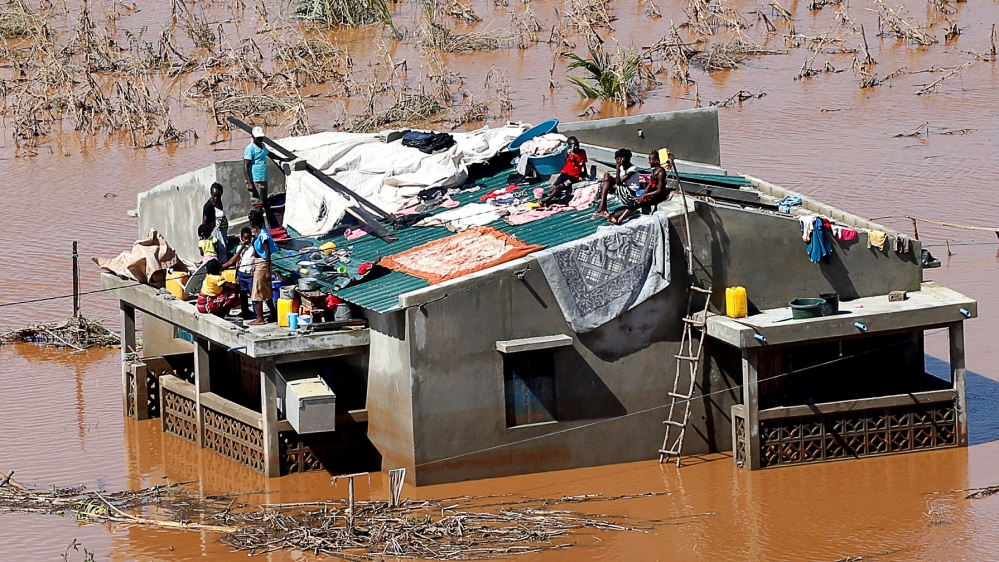Death toll jumps in Mozambique storm as 15,000 await rescue
The death toll from a powerful cyclone that triggered devastating floods in three southeastern African countries has jumped to more than 400 people, according to officials, as thousands of people remained stranded “in very bad shape” on roofs and trees in hard-hit Mozambique.
Speaking to reporters on Thursday, Celso Correia, Mozambique’s land and environment minister, put the number of dead in the country at 242 but warned that the figure was rising as rescue workers found bodies that had been hidden by now-receding floodwaters.
“Our biggest fight is against the clock,” he said in the flood-ravaged port city of Beira.
“Yesterday, we had counted 15,000 people that still need rescue today – 15,000 people who are in bad shape. They are alive, we are communicating with them, delivering food, but we need to rescue them and take them out.”
Cyclone Idai hit Beira, home to around half a million people, with winds of up to 170 kilometres per hour last Thursday, before moving inland to Zimbabwe and Malawi. It flattened buildings and triggered flash floods that wrecked roads and submerged entire villages across the region.
According to UN estimates, at least 400,000 people could be displaced in Mozambique
In Zimbabwe, state broadcaster ZBC said the death toll had risen to 139, up from 100 on Wednesday, while the World Food Programme (WFP) said 200,000 Zimbabweans would need urgent food aid for three months.
In Malawi, 56 people were confirmed dead, and 82,000 people were displaced.
United Nations officials say this could be the worst-ever weather-related disaster to have struck the southern hemisphere.
‘Very large number of victims’
In Mozambique, the cyclone’s torrential rains caused the Buzi River and the Pungue River, whose mouths are in the Beira area, to flood their banks. The scale of the flooding is huge, with floodwaters covering 2,165sq km, according to the UN.
“This is an unprecedented challenge for this community,” Dominique Costa, a community leader, told Al Jazeera.
“We are right on the highway, but it’s shocking that we seem to be invisible. We have a real crisis here. These people have escaped violent death, do you want to see them die now because of diseases due to overcrowding and lack of toilets?”
In the worst-affected district of Buzi, flooding has created a muddy inland ocean 125km-long and 11-metres deep, according to Pedro Matos, emergency aid coordinator for the WFP in Beira.
The district is home to some 200,000 people.
“Either they were able to flee or there are very large number of victims,” he told the DPA news agency.
Al Jazeera’s Fahmida Miller, who joined a helicopter flight over the region, said only the roofs of buildings were visible in some parts of Buzi.
“Stagnant water lies across the horizon, stretching out for as far as the eye can see. There is very little dry land,” she said. “It’s not known how many people made it out safely.”
In one village near the Buzi River, floodwaters have marooned hundreds of people in a basketball stadium, Miller reported.
“People who are stranded are sitting, waiting and sleeping on a battered grandstand – a short, but uncertain reprieve.”
 |
| A stranded family sits on top of their home after Cyclone Idai, in Buzi district, outside Beira [Siphiwe Sibeko/ Reuters] |
As torrential rain lifted on Thursday, aid groups around Beira continued to rescue families clinging to tree branches and rooftops.
“Yesterday, 910 people were rescued by the humanitarian community,” said Caroline Haga of the International Federation of the Red Cross in Beira. She added that 210 were rescued by five helicopters and 700 were saved by boats.
“We’re hoping to rescue as many as we can today as it is not raining,” she said. “Rescue activities will continue until everyone is brought to safety.”
Correia, the environment minister, said some 65,000 displaced people had taken refuge in transit centres. But some 30 percent of the 88 government-run centres were still without food, he added.
“Our priority now is to make sure we take food, shelter and medicine to the people that are isolated in small islands or in big islands and villages,” Correia said.
The International Federation of Red Cross and Red Crescent Societies said it was sending two emergency units to Beira that would provide drinking water for up to 15,000 people and sanitation facilities for 20,000 people, as well as shelter kits.
“More help is needed, and we are continuing to do all we can to bring in more resources and to reach more people,” said Jamie LeSueur, the IFRC’s operations head in Mozambique.
The WFP said it has stepped up airdrops of high-energy biscuits and water purification tablets to people stranded by the floodwaters.
Enock Muchinjo contributed to this report




